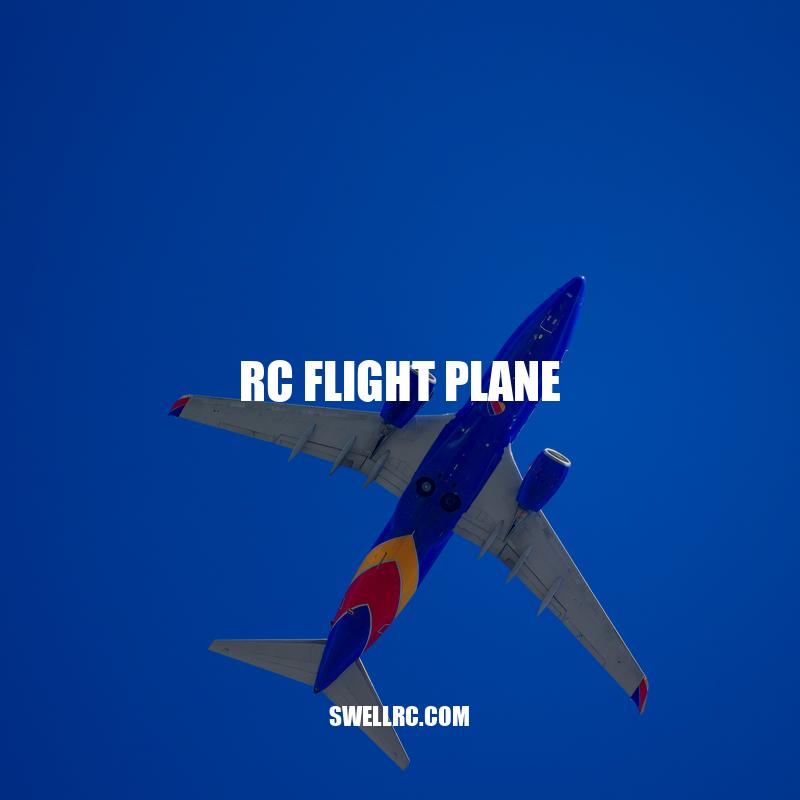Get Your Wings: A Guide to RC Flight Planes
RC flight planes are miniature remote-controlled airplanes that are flown for recreation or competition purposes. This hobby has become increasingly popular in recent years with flyers ranging from young kids to adults. The planes can be bought pre-built or as a kit to be assembled by the individual. Primarily, there are three types of RC planes: trainers, park flyers, and 3D planes. Trainers are designed for beginners who want to learn how to fly an RC plane. Park Flyers are compact planes that can be flown in small areas like gardens and parks. On the other hand, 3D planes are aerobatic planes designed for experienced flyers, and can perform crazy maneuvers like flips, rolls, spins, etc. In addition to being a fun and exciting activity, RC flight planes offer a unique sense of challenge and skill development. The flyers have to maintain control and navigate the plane in the air without crashing while performing different kinds of stunts. Flying RC planes is an excellent way to improve hand-eye coordination, quick reflexes, and patience.
RC planes come in various shapes, sizes, and types, each with its own advantages and challenges. Here are the popular types of RC flight planes.
Trainers
Designed for beginners and new flyers, trainers have a stable and straightforward flying style. They are easy to fly and can be controlled in different weather conditions. The plane can be powered by an electric or gasoline motor.
Park Flyers
Perfect for flying in a small outdoor area, park flyers are lightweight, agile and easy to fly planes. They are designed for beginners who find the trainers too large and can fly in tight spaces or indoors.
3D Planes
Designed for expert flyers who want to do aerobatics, 3D planes are able to perform impressive stunts, such as flips, rolls, and spins. They require more skill and precision to fly and are not suitable for beginners.
When selecting an RC plane, there are several features to consider, such as wing size, weight, motor power, and range. Aspiring flyers can buy RC flight planes from different sources. Online shops like Amazon, hobby shops, and local classifieds offer a variety of planes, parts, and accessories. Manufacturers like HobbyZone, Eflite, and ParkZone offer a wide range of planes, including trainers. Additionally, online forums like rcgroups.com, rcaerobatics.net offer a wealth of knowledge through the perspective of experienced pilots. They provide tips on how to get started on the hobby, how to choose the right model, and how to maintain the plane.
What is the best RC plane to buy?
There are a variety of great RC planes to choose from, depending on your needs and experience level. Some options include the VOLANTEXRC MiniTrainstar, E-flite UMX Turbo Timber BNF Basic, VOLANTEXRC RC Airplane 2.4Ghz 4-CH Sport Cub 500 Parkflyer, VOLANTEXRC 4-CH RC Airplane P51 Mustang, Top Race RC Plane 4 Channel TR-C385, Top Race RC Plane TR-C285G, E-flite RC Airplane Pitts S-1S 850mm BNF Basic, and E-flite UMX Timber RC Airplane Ultra Micro. Check reviews and specifications to determine the best fit for you.
Building a Custom RC Flight Plane
Building an RC plane from scratch may seem daunting but can also be an exciting and rewarding experience. Here is some information to help you get started:
The process of building an RC plane
- Start by selecting a good plan and gathering materials: Common materials include balsa wood, foam, carbon fiber, and fiberglass.
- Cut out the plane’s parts from the materials using a template or a CNC machine.
- Assemble the wings, fuselage, tail section and then install the motor, servos and ESC according to the instruction manual.
- Paint and apply decals to the completed plane for customization.
The Benefits of Building an RC Plane
- Customizable: Building your own plane allows you to control every aspect of the aircraft, from the materials used to the paint job and the plane’s design.
- Educational: Building a plane helps you understand how planes work and also gives a sense of satisfaction and ownership.
- Cost-effective: Building a plane from scratch can be more cost-effective than buying a premade one.
| Materials Used for Building an RC Plane | Benefits of Each Material |
|---|---|
| Balsa wood | Lightweight and easy to cut, making it easy to work with. |
| Foam | Durable and can be shaped in any form, making it a popular material for beginners. |
| Carbon fiber | Strong and lightweight, which makes it a perfect choice for high-end RC models. |
| Fiberglass | Strong and good against crashes. Ideal for outdoor flying where the wind could affect the plane. |
Building an RC plane requires some time and patience, but it can also be a fulfilling experience. Starting with a simple design and with the right materials can help you achieve success, and as you gain expertise, you can create more complex builds. Sites such as FliteTest and RC Universe offer forums and tutorials, which cover building techniques and other essential aspects of flying an RC plane.
Can you build an RC plane from scratch?
Yes, you can build an RC plane from scratch by acquiring the main components such as the body, wings, rudder, wheels, motor, and radio transmitter. Building RC planes is now more convenient with the availability of affordable radio equipment and efficient batteries and motors. For more information on building an RC plane from scratch, you can check out websites such as rc-airplane-world.com or hobbyking.com.
Flying an RC Flight Plane: Tips and Tricks
Flying an RC plane is not just about holding a remote control and making the plane take off. It takes practice and skill. Here are some tips to help improve your flying:
Flying Tips
- Start with a small and lightweight plane as it will be easier to control.
- Always choose an open area free of obstacles where you can fly the plane safely.
- Take your time while flying and do not hurry. Rushing could lead to accidents.
- Pay attention to the weather conditions when flying. Windy weather, for instance, could affect the stability of the plane.
Safety Measures
- Wear a pair of protective goggles to avoid eye injuries that can result from a plane propeller.
- Avoid flying too close to people or animals to prevent accidents.
- Use a proper RC transmitter. A radio-controlled vehicle’s transmitter should be able to provide a range of up to 2000 feet.
- Always fly with a spotter that will be your eyes when the plane is out of your sight range.
Online Resources
Learning RC flying through online resources has become more accessible over the years. Here are some recommended websites and resources for flying tips, tricks and tutorials:
- RCGroups.com – Offers a forum for discussions on RC planes, buying guides, and product reviews.
- The AMA (Academy of Model Aeronautics) – Provides manuals, guides, and resources for members of the Academy as well as flying locations and a community of RC flying enthusiasts.
- Flite Test – Features free tutorials, build kits and information on the latest products and plans for RC flying enthusiasts.
Safety measures are essential when it comes to flying an RC plane. Collisions and accidents can happen anytime, even when all safety precautions are observed. Choosing the right location and following the tips mentioned earlier will help you avoid them. Finally, joining an RC flying club and attending events is great for both beginners and intermediates alike. Being a member of a group gives you a sense of community and support, which can make the hobby even more enjoyable.
Is it hard to fly a RC plane?
Learning how to fly a RC plane is not as difficult as some may think. However, it does require practice and patience. Many beginners make the mistake of purchasing an expensive plane without first mastering the basics. It’s important to start with a more affordable and durable trainer plane, and then work your way up to more advanced models. There are plenty of resources available online, including instructional videos and forums where experienced RC pilots can offer advice and support. It’s also worth investing in a good quality remote control and simulator software to help with practicing. With the right approach and resources, anyone can learn to fly a RC plane.
Conclusion
In conclusion, flying RC planes is an exciting and rewarding hobby that can provide a sense of accomplishment and enjoyment. With numerous types of planes available, such as trainers, park flyers, and 3D planes, there is something for everyone no matter their skill level or interests. Additionally, building an RC plane can be a fun and creative project that allows for personalized modifications and repair capabilities. Safety measures such as following appropriate locations, wearing protective gear, and finding a community to learn and share experiences with are essential to the hobby.
While the idea of starting a new hobby can be daunting, taking the first step into the world of RC flight planes can lead to a life of fun and excitement. With the help of online resources and dedicated clubs, there has never been a better time to join the ever-growing community of RC flight enthusiasts. So, why not take the plunge and experience the thrill of flying your very own RC plane today?



